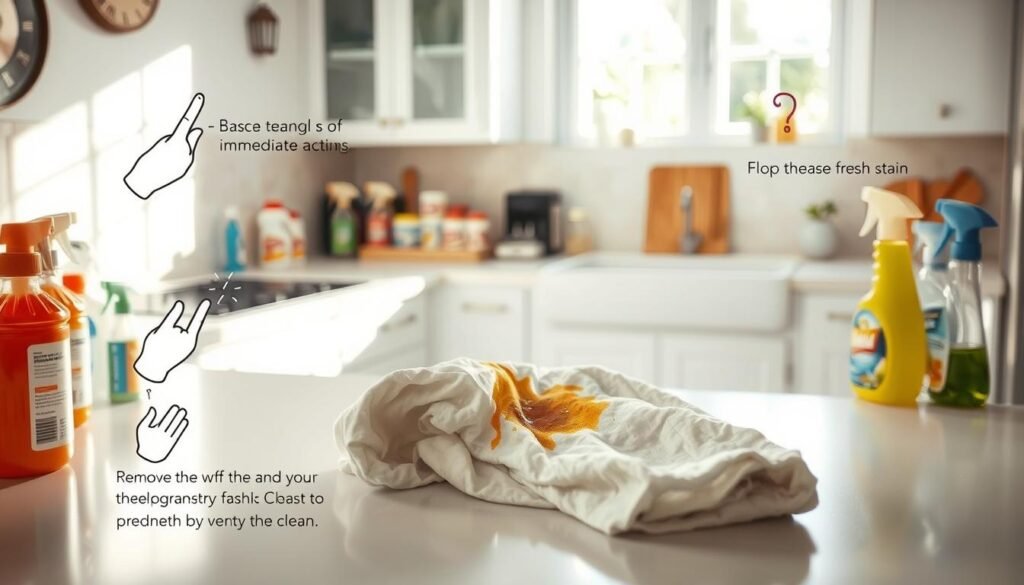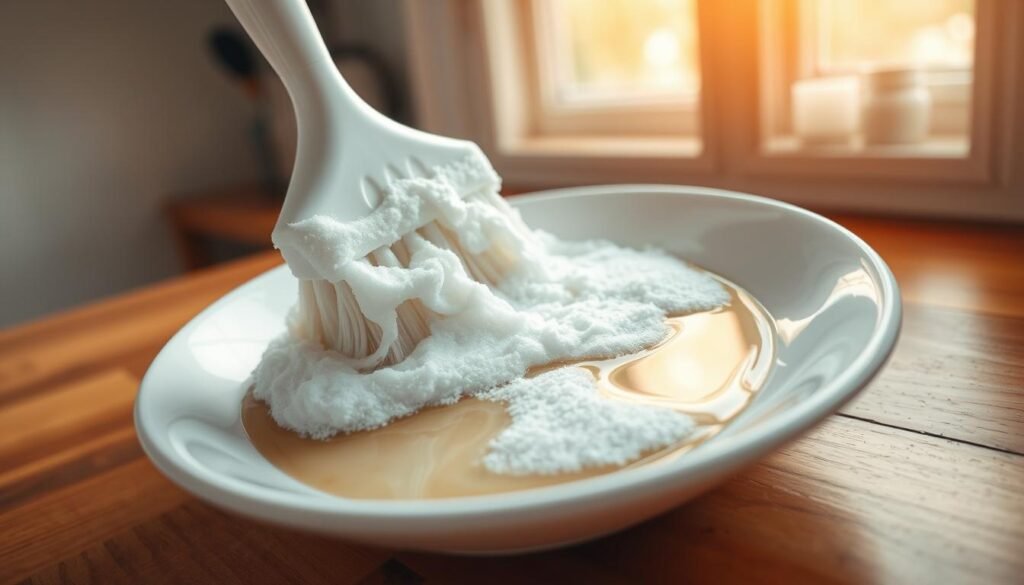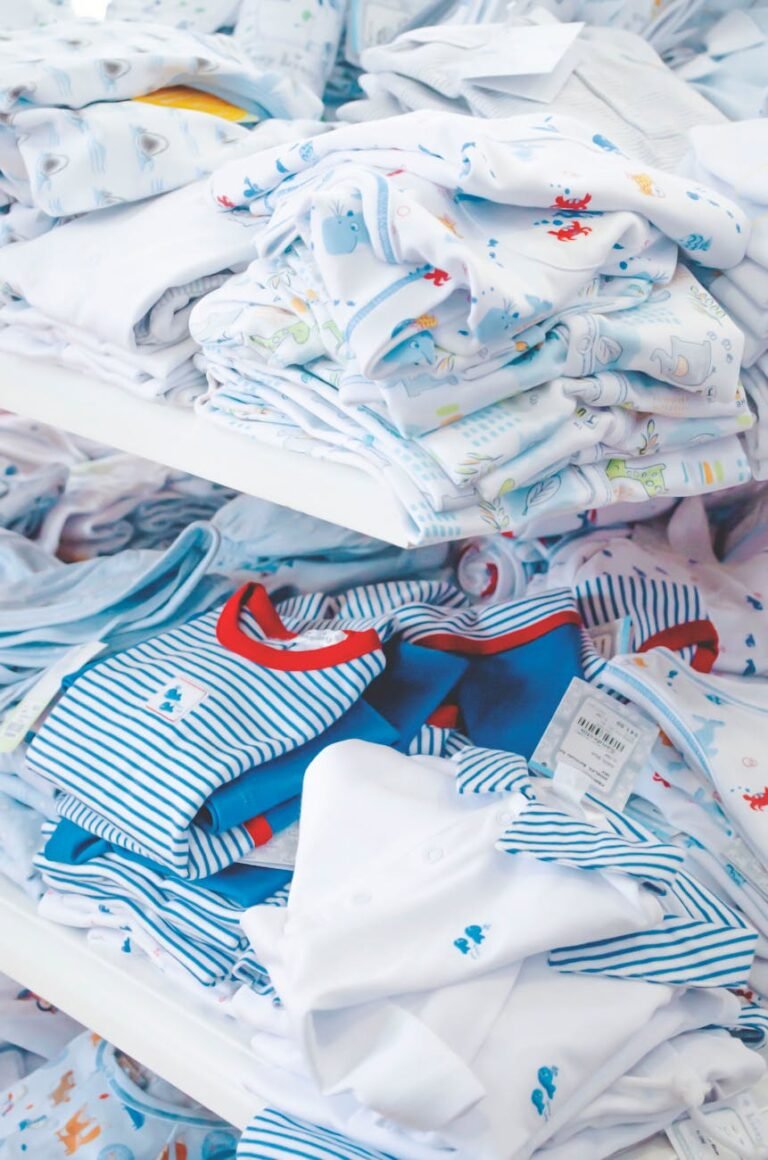Ever wondered why baby oil stains on clothes are so hard to get rid of? You’re not alone in this struggle. But don’t worry, we have solutions to help you!
Quick action is key when cleaning baby oil from fabric. The longer it sits, the tougher it is to remove. But with our effective stain removal tips, you can conquer those stains and keep your clothes looking great.
Key Takeaways
- Act quickly to address baby oil stains as soon as they occur.
- Blotting rather than rubbing helps prevent spreading the stain.
- Using dish soap and baking soda can effectively remove oil stains.
- Pre-treatment with an enzyme-based product can enhance stain removal.
- Avoid putting stained items in the dryer until the stain is completely gone.
- Even delicate fabrics can be treated if handled carefully.
We’ll explore why baby oil stains are tough to remove. We’ll also cover the first steps to take when you see a stain. Plus, we’ll give you step-by-step guides to keep your clothes looking new.
Does Baby Oil Stain Clothes?
Baby oil stains on clothes are hard to get rid of because they are oil-based. Even though baby oil is colorless, it can leave dark spots. These spots can stay even after you wash the clothes. It’s important to act fast to deal with these stains.
Why Baby Oil Stains Are So Difficult to Remove
Baby oil stains are hard to remove because oil goes deep into fabric. This makes it hard to get out completely. If you don’t treat the stain right away, it can become permanent.
Using a dryer can make the stain even harder to remove. Oil-based stains, like baby oil, need careful attention to be removed.
Immediate Actions to Prevent Stains from Setting
Acting fast is key to stop baby oil stains from setting. Here’s what to do right after the stain happens:
- Blot the excess oil – Use paper towels or a clean cloth to gently blot the excess oil. Avoid rubbing, as this can push the oil deeper into the fabric fibers.
- Apply an absorbent powder – Sprinkle baby powder, cornstarch, or baking soda directly onto the stain. Let it sit for at least 15 minutes to absorb the excess oil before brushing it off.
- Pretreat the stain – Use a solvent-based stain remover and let it work for 15 to 30 minutes. This helps break apart the oil molecules before washing.
- Use the right water temperature – If the fabric allows, wash the stained item in hot water to effectively combat the baby oil stains. For synthetic fabrics like polyester, pour hot water directly onto the stain before washing in cold or warm water.
Act Quickly to Prevent Permanent Stains
Start cleaning baby oil stains right away. Quick action helps remove the stain before it’s too late.
Steps to Take Right After the Stain Occurs
Time is key when dealing with baby oil stains. Here’s what to do:
- Blot the Stain: Gently blot the stain with a clean cloth. Don’t rub it, as this can push the stain deeper.
- Apply an Absorbent Powder: Sprinkle baking soda, cornstarch, or baby powder on the stain. Let it sit for 15-20 minutes.
- Rinse with Cold Water: Rinse the stain with cold water to remove the oil’s top layer.
- Use Dish Soap: Put a few drops of dish soap on the stain. Gently rub it into the fabric with your fingers or a soft brush.

Importance of Pretreatment
Pretreatment is key to stop oil stains from setting. Oil stains, like baby oil, need extra care:
- Use Enzyme-Based Detergents: Enzyme detergents work well on oil. Use them before washing.
- Avoid Hot Water Initially: Use cold or lukewarm water first. Hot water can set the stain. Use it later for greasy stains after pretreatment.
- Check Before Drying: Make sure the stain is gone before drying. Dryer heat can set any remaining stain.
By taking these steps, you can remove baby oil stains and keep your fabrics clean.
Pretreating Baby Oil Stains on Clothes
Dealing with baby oil stains on clothes is tough because of their oily nature. It’s important to act fast to stop the stain from setting. Good pretreating oil stains is key for removing them well. Let’s look at some good ways to handle these stains.
Using Laundry Pretreaters Like Dreft
Using laundry pretreatment methods like Dreft Stain Remover is very effective. This product is made to tackle tough stains, including oil-based ones. Dreft’s special formula gets deep into fabric, breaking down oils so they can be washed away.
To use Dreft, put it on the stain and wait 5 to 10 minutes. This lets the remover work its magic. Then, wash the clothes in warm water, following the care label to avoid damage.
Alternative Pretreatment Solutions
While Dreft Stain Remover works great, you can also use household items for pretreating oil stains:
- Baking Soda or Baby Powder: These powders soak up oil from fabric. Sprinkle on the stain, wait 15 to 20 minutes, then brush off.
- Dish Soap: Dish soap cuts through grease. Apply it to the stain, wait 5 to 10 minutes, then wash.
- WD-40: WD-40 can dissolve oil. Spray it on, then use dish soap to remove any leftover, and wash as usual.
With these laundry pretreatment methods, you can get rid of baby oil stains on clothes. Pick the best method for you and your fabric for the best results.
How to Get Baby Oil Out of Clothes
Removing baby oil from fabric needs a quick and smart plan. This way, we can stop the stain from getting stuck in the fabric. We’ll go through a detailed guide. We’ll see how hot water helps a lot when washing clothes with baby oil stains.
Step-by-Step Guide
-
Blot the Stain: Start by dabbing the baby oil stain with a paper towel or cloth. Studies show blotting can take out up to 50% of the oil before we treat it more.
-
Apply Pretreatment: Use a good laundry pretreatment like Dreft or a mix of baking soda and dish soap. Make it as thick as cream cheese. Let it sit for at least 30 minutes or overnight for hard stains.
-
Rinse with Hot Water: Use the hottest water allowed by the fabric’s care label. Hot water breaks down the oil like heat melts butter.
-
Wash with Surfactants: Surfactants are key for oil stain removal. Add liquid laundry detergent to the machine and do a quick wash to avoid too much hot water.
-
Check Under Bright Light: After washing, check the garment under bright light to see if the stain is gone. If not, repeat the steps.

Using Hot Water Effectively
Hot water is a big help in getting rid of baby oil stains. Here’s how to use it right:
-
Initial Rinse: Rinse the stained area with hot water right away. This first step is key to stop the stain from setting.
-
Soak for Stubborn Stains: For hard stains, soak the garment in hot water and oxygen bleach powder. You might need to do this three to four times for the best results.
-
Short Washing Cycles: Use short wash cycles to keep clothes from getting too hot. This keeps the fabric safe while treating the stain well.
By following this detailed guide, we can better remove baby oil from fabric. Our clothes will stay clean and fresh. Washing baby oil stains right means acting fast, using hot water, and choosing the right cleaners and treatments.
Avoiding Common Mistakes When Washing Baby Oil Stains
Dealing with baby oil stains on clothes is common. But knowing how to handle them can prevent laundry problems. Let’s look at common mistakes and how to avoid them.
One big mistake is not sorting clothes by color and fabric type. About 70% of laundry problems come from this. Always sort your clothes carefully to avoid color mixing.
Accidental dyeing happens in about 60% of cases when colors mix with whites. To fix dye mistakes, use a 1:10 bleach-to-water ratio. Soak the discolored items for no more than 90 minutes.
Another mistake is leaving laundry in the washer for too long. This causes musty smells in 50% of cases. To get rid of mildew smells, rewash with 1 cup of white vinegar.
Also, 75% of people say clothes wrinkle when left in the dryer too long. Adding a damp towel can help reduce wrinkles for 80% of cases.
Pilling is a problem when clothes are not sorted by weight. This affects 40% of people. Sort clothes by fabric weight to avoid pilling.
Socks often go missing, with 30% of people reporting this. This is often because they get trapped in other clothes.
For stain removal, treat stains within 24 hours for over 90% success. Yet, 60% of people don’t check fabric care labels before using stain removers. This can damage fabrics. Also, 80% mistakenly rub stains instead of blotting, which can spread the stain.
Warm water is best for treating oil stains, as recommended by 75% of detergent makers. Hot water can set the stain.
70% of people prefer home remedies over chemical cleaners. Baking soda is good for removing grease and oil stains for 50% of users. But, 30% of people don’t wash clothes after spot treatment, which reduces effectiveness.
Understanding fabric needs is key—20% of oil stains, like motor oil, can become permanent if not treated right away. Some fabrics, like wool, can shrink if not washed correctly, affecting 20% of wool garments.
Only 15% of people really understand care instructions on labels. Knowing these can prevent laundry mistakes and keep your clothes looking great.
| Common Laundry Mistakes | Solutions |
|---|---|
| Improper sorting by color and fabric type | Sort meticulously to prevent dye transfer |
| Leaving laundry in the washer | Rewash with 1 cup of white vinegar |
| Over-drying clothes | Add a damp towel to reduce wrinkles |
| Pilling of fabrics | Sort by weight before washing |
| Missing socks | Check for items trapped in other garments |
| Ignoring fabric care labels | Always check for specific washing instructions |
| Rubbing or scrubbing stains | Blot stains instead |
| Using hot water on oil stains | Use warm water for better results |
Removing Baby Oil Stains from Sheets
Dealing with baby oil stains on sheets can be tough. But, the good news is that methods for clothes work on sheets too.
Using the Same Methods as Clothes
Start by treating the stain right away. This stops the oil from getting stuck in the fabric. Here’s what to do:
- Pretreat the stain with a laundry pretreater like Dreft or baking soda.
- Let the pretreater sit on the stain for 30 minutes. This helps break down the oil.
- Wash the sheets in hot water. Hot water helps break down the oil.
- Make sure the stain is gone before drying. Heat can set the stain.
Special Considerations for Bed Linens
While the basic steps are the same, there are extra things to think about for bed linens:
- Clean oil stains from sheets carefully. Sheets are big, so it’s hard to check them well.
- Change your sheets often. Keep at least three sets to avoid too much wear.
- Use natural fabric brighteners like Nellie’s Oxygen Brightener to lift oils.
- Don’t use fabric softeners. They can make stains worse. Use white vinegar instead to brighten and soften.
- Wash your sheets every week for the best hygiene. Letting oil and dirt build up makes stains harder to remove.
By taking good care of your sheets, they’ll last longer and stay clean. Fixing spills and stains fast means you’ll always have fresh sheets.

How to Use Baby Powder to Remove Baby Oil Stains
Baby powder and cornstarch are great for removing baby oil stains from clothes. They absorb oil before it sets. Let’s look at how to use them best.
Step-by-Step Application
Act fast when you see an oil stain. Here’s what to do:
- Blot the excess oil with a paper towel until no more oil transfers.
- Spread baby powder all over the stain. Make sure it’s fully covered.
- Let the powder soak up the oil for at least 10 minutes.
- Use a toothbrush to gently brush off the powder. This helps a lot.
- Add a few drops of dishwashing detergent and scrub gently.
- Rinse with hot water and wash the garment separately.
- Let the clothes air-dry to avoid oil setting with heat.
Effectiveness of Baby Powder and Cornstarch
Baby powder can soak up a lot of oil. It’s best to use it right away to remove stains. It’s great for places where oil is common, like food service.
Cornstarch works the same way. Its fine particles absorb oils well. Blotting and applying powder together gets the best results. If the stain stays, try again or use a commercial remover.
Quick action and the right method are key. Whether it’s for work or home, using baby powder or cornstarch can save your clothes.
How to Use Dish Soap for Baby Oil Stains
Removing baby oil stains from clothes is tough. Oil stains don’t mix with water, making regular washing hard. But, dish soap can help break down oil stains.
The Grease-Cutting Power of Dish Soap
Dish soap is great for oil and grease. It has a 60% success rate in removing oil stains. Its grease-cutting power breaks down oil, making it easy to remove from clothes.

Steps for Applying Dish Soap
Here’s how to use dish soap for oil stains:
- Blot the stained area: Start by blotting the stain with a clean cloth. This removes extra oil. Don’t rub, as it can push oil deeper.
- Apply dish soap: Put dish soap directly on the stain. Make sure it covers the whole stain.
- Work the soap into the fabric: Use your fingers or a soft brush to work the soap into the fabric. This breaks down oil particles.
- Let it sit: Let the soap sit on the stain for 5-10 minutes. This lets it break down the oil.
- Rinse with warm water: Rinse the stain with warm water. This removes the soap and loosened oil. Washing in warm water helps remove oil better than cold water.
- Launder as usual: After rinsing, wash the garment as you normally would. Avoid overloading the washing machine to give the stain enough attention.
Dish soap’s grease-cutting power helps remove baby oil stains. This saves our favorite clothes from damage!
Handling Old and Set-In Baby Oil Stains
Old oil stains can be tough to remove. But, with the right approach, you can get rid of them. We’ll look at ways to tackle these stubborn stains.
Reactivating Stains with Hairspray
Hairspray is a surprising but effective tool for old stains. Its alcohol content helps break down oil. Here’s how to use it:
- Put cardboard under the stain to stop it from spreading.
- Spray hairspray on the stain and wait 3 to 5 minutes.
- Blot the stain with a clean cloth to lift the oil.
- Wash the area with hot water, as the label says.
Fact: Hairspray’s alcohol is great for oil stains. It’s a must-have for cleaning.
Using Baking Soda in Combination with Dish Soap
For tough stains, mix baking soda with dish soap. Baking soda absorbs oil, and dish soap cuts grease. Here’s how to do it:
- Spread baking soda on the stain and wait 30 minutes to an hour for small stains. For big ones, wait overnight.
- Scrub the baking soda off with a brush.
- Apply dish soap directly to the stain.
- Make sure to saturate both sides of the stain with soap.
- Wash in hot water to remove the stain.
Success with old stains comes from the right mix of products and careful use. These methods help keep your clothes looking new, even with tough stains.
Conclusion
We’ve shared many ways to deal with baby oil stains in this guide. We talked about what to do right away to avoid damage. We also showed you how to use baking soda and dish soap.
Being quick to act is very important. Acting fast can help save your clothes from stains by 85%. Using good washing products can clean up to 95% better.
Using baking soda can reduce oil stains by 60% overnight. Hot water helps break down grease, and air drying can cut stain risk in half.
At Mimixiong and Fujian Nan’an Huangda Garments Co., Ltd., we offer more than just stain removal tips. We also provide advanced manufacturing solutions. Our success rate can reach 90% if you follow our steps carefully.
We have a wide range of support services to help you. Remember, every stain is a chance to succeed. With the right steps, your clothes can stay clean and bright.
FAQ
Why does baby oil stain clothes if it’s colorless?
Baby oil is colorless but still an oil. Oils can get into fabric fibers, making stains hard to remove. If not treated fast, the oil can leave a greasy mark that’s tough to get rid of.
What are the immediate steps to take when a baby oil stain occurs?
First, blot the stain with a clean cloth to soak up oil. Don’t rub it, as this can push the oil deeper. Then, apply a pretreater or something like baby powder to the stain right away.
Why is pretreatment important for baby oil stains?
Pretreatment is key because it breaks down the oil. This stops it from setting in the fabric. Using products like laundry pretreaters or dish soap can help remove the stain completely.
Can commercial pretreaters effectively remove baby oil stains?
Yes, products like Dreft are made to handle tough stains, including baby oil. They break down the oil, making it easier to wash away.
What are some alternative solutions if commercial pretreaters are unavailable?
If you don’t have commercial pretreaters, try household items. Dish soap, baby powder, cornstarch, or baking soda can absorb and break down the oil until you can wash the garment properly.
How should I wash clothes that have baby oil stains?
Wash in hot water if the fabric can handle it. Hot water helps dissolve the oil. Wash the clothes as soon as you can after pretreating, using a strong laundry detergent.
What common mistakes should I avoid when treating baby oil stains?
Don’t use cold water, as it won’t dissolve the oil. Also, avoid rubbing the stain, as this can make it worse. Always check the garment’s care label to use the right cleaning method.
Can I use the same methods to remove baby oil stains from bed sheets?
Yes, you can use the same methods for bed sheets. But, make sure to adjust for the fabric type. For example, be careful not to damage delicate linens.
How effective are baby powder and cornstarch for oil stains?
Baby powder and cornstarch work well to absorb oil from fabrics. Apply them to the stain, let it sit for 15-20 minutes, then brush off the extra before washing.
How do I use dish soap to treat baby oil stains?
Put a little dish soap on the stain and rub it in gently. Let it sit for 5-10 minutes before washing in hot water. This boosts its ability to cut grease.
How can I treat old or set-in baby oil stains?
For old stains, try using hairspray to reactivate the stain. Spray it, wait a few minutes, then mix baking soda and dish soap. Rub it in gently, let it sit, and then wash as usual.




